Understanding the Financial Aspects of Kite Surfing

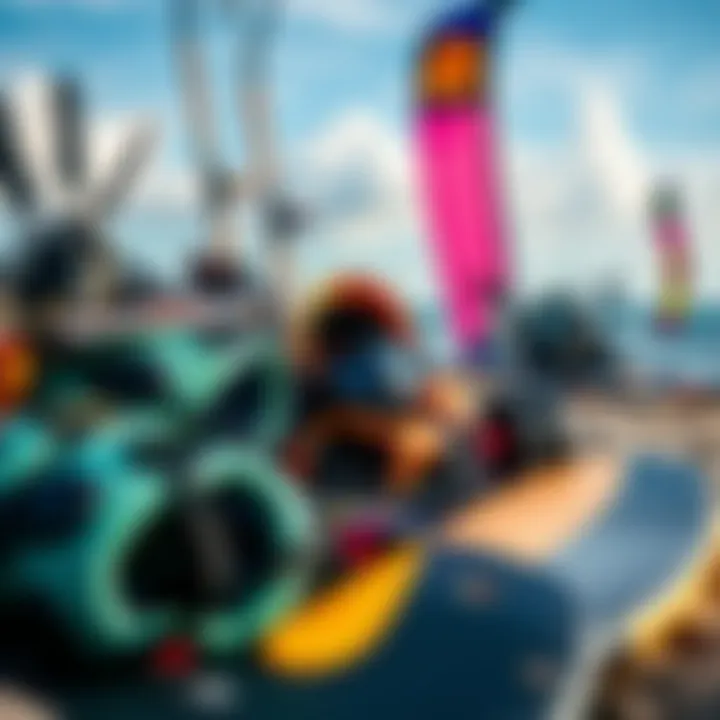
Intro
Kite surfing, while exhilarating, brings along its share of financial considerations that often catch enthusiasts off guard. Whether you're just dipping your toes into the world of kite surfing or you’ve already carved your name in waves, understanding the monetary landscape is crucial. The endeavor is not limited to just the purchase of a kite or harness; it encompasses a variety of ongoing costs that can accumulate if one is not careful.
In this article, we’ll delve into the various facets of spending that are inherent in kite surfing, ensuring that you're well-informed before you hit the water. By bringing everything from gear purchases to maintenance fees and travel costs into sharp focus, you'll be armed with the knowledge to manage your budget effectively while still enjoying your sport. Let's dive into the nitty-gritty of kite surfing costs and make sensible financial decisions that allow you to ride the wind smoothly.
Prelude to Kite Surfing Costs
Kite surfing, more than just a captivating sport, is a unique blend of skill, adventure, and connection with nature. To enjoy this thrill ride, a clearer understanding of the costs involved is imperative. By breaking down the various expenses related to gear, lessons, and ongoing upkeep, potential enthusiasts can prepare themselves better and make informed choices.
A vital element of kite surfing is not only the exhilaration it offers but also the investment it demands. It’s essential for newcomers to grasp these financial commitments so that budgeting doesn’t become a soggy patch on their adventurous journey. Whether you’re a weekend warrior or aiming for more rigorous pursuits, understanding the costs ensures that you can ride the waves without a financial hangover.
Being aware of what you'd be spending goes a long way — from purchasing the right equipment to booking lessons, each step has its price. This article aims to shine a light on all these aspects, painting a detailed picture of the financial landscape that surrounds kite surfing.
Defining Kite Surfing
At its core, kite surfing is a water sport that combines aspects of surfing, windsurfing, and paragliding. Riders harness the power of the wind with a large, controllable kite while standing on a board. The excitement comes from gliding over the water, performing tricks, or simply enjoying the rush of free movement. The fundamental appeal of kite surfing lies in its adaptability — anyone with an adventurous spirit can partake. Unlike many sports that require narrow conditions, kite surfing thrives in a variety of environmental situations.
The Growing Popularity of the Sport
Kite surfing has seen a surge in popularity over the last few decades. Once a niche activity favored by a select few, it has now carved out a space among mainstream outdoor sports. As the world shifts towards more adventure-based recreational activities, kite surfing fits perfectly into this trend.
Its growing presence can be linked to several factors. Firstly, the arrival of more accessible gear has lowered the entry barrier. Nowadays, you’d be hard-pressed to find a beach that doesn’t have a few kite surfers catching the wind. Additionally, social media has helped in broadcasting stunning visuals of the sport to a broader audience, enticing both seasoned athletes and greenhorns alike to grab a kite and board.
"Adventure is worthwhile." - A quote that resonates well with kite surfers, reminding everyone that the thrill is a significant motivating factor.
As the sport continues to expand, the necessity of staying informed about the associated costs becomes more crucial. Understanding these elements can lead to healthier participation rates, fewer surprises, and an overall enjoyable experience.
Initial Equipment Investment
When diving into the exhilarating world of kite surfing, understanding the initial equipment investment is paramount. This phase not only sets the foundation for your experience but also enhances the joy of mastering the sport. Kite surfing is not just a seasonal hobby; it’s a lifestyle for many, and investing wisely in the right gear will ensure you get the most out of it. The right equipment can significantly impact your performance, safety, and ultimately your enjoyment on the water.
Kite Types and Prices
The kite is undeniably the heart of your kite surfing setup. Selecting the right type hinges on several factors, including your skill level, the wind conditions you'll be surfing in, and your personal preferences. Kites primarily fall into two categories: inflatable kites and foil kites.
- Inflatable Kites: These are widely popular among beginners. They are easier to launch, land, and relaunch after a crash. Prices can range from about $800 to $1,500 or even more based on the brand and size.
- Foil Kites: These tend to be favored by more advanced riders because of their excellent efficiency and performance in light winds. However, they're generally more complex to handle. The price span is similar, approximately $900 to $2,000.
When deciding, consider how adaptable the kite is for various conditions. It's also wise to think about purchasing a used kite if you're just starting out; it could save a significant chunk of change without sacrificing quality too much.
Boards and Other Essential Gear
Once you've settled on a kite, the next essential piece to invest in is the board. The board affects your speed, control, and comfort while riding. There are a few key types to consider:
- Directional Boards: Great for wave riding, they cater to surf-focused kite surfers. Prices typically range from $500 to $1,200.
- Twin-tip Boards: Ideal for beginners, these boards are versatile and can be ridden in both directions. They're often the go-to choice for newcomers, and you can expect to pay around $400 to $1,000.
- Beginners Packages: Some retailers offer entire sets which include a board, kite, and sometimes the harness. These can often be a good deal, running between $1,500 to $3,000 depending on the items included.
Aside from the boards, don’t forget about other vital pieces of gear like a bar and lines which can cost an additional $300 to $600, plus a pump to inflate your kite, commonly priced around $30 to $100.
Harnesses and Safety Equipment
Safety should always be top of mind in kite surfing. Your harness is your direct link to the kite and ensuring it fits well makes a marked difference in comfort and performance. There are three main types of harnesses:
- Waist Harness: These offer great mobility and are suitable for most riders. Prices generally vary from $100 to $300.
- Seat Harness: Preferred by many beginners, these provide extra support and are less likely to ride up. They usually range from $80 to $250.
- Impact Vests and Buoyancy Aids: In addition to harness selection, adding safety equipment is essential. An impact vest can cost between $50 and $150 and is often recommended for increased safety, especially for new riders.
"Being well-equipped doesn’t just keep you safe, it makes your learning curve smoother, paving the way for greater enjoyment down the line."
In summary, while the initial equipment investment may seem hefty, it forms the backbone of your kite surfing journey. Ensuring you select quality gear tailored to your needs can foster a more enjoyable, safer, and ultimately rewarding experience as you embrace this thrilling sport.
Cost of Lessons and Training
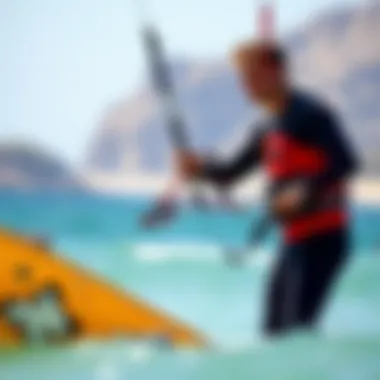
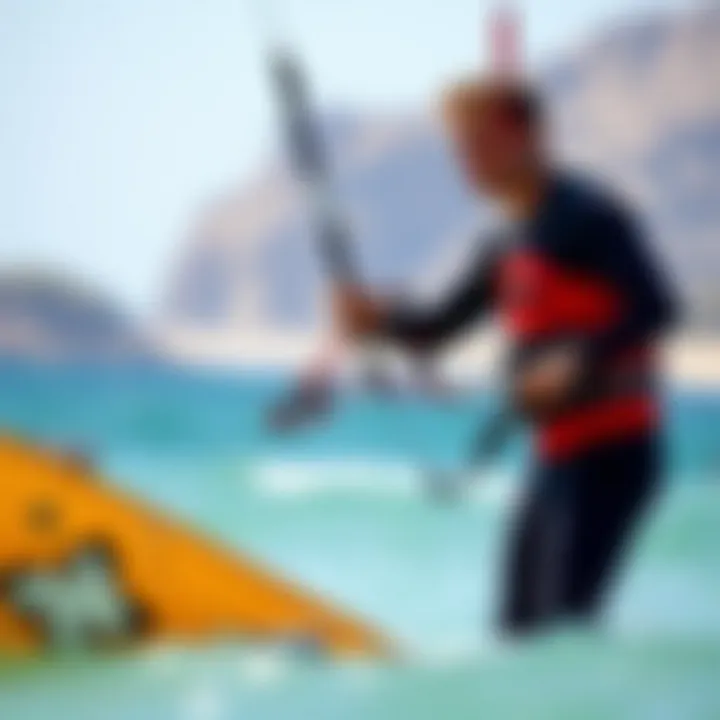
When diving into the world of kite surfing, many beginners often feel overwhelmed by the sheer array of costs associated with the sport. While gear and equipment may seem like the initial big-ticket items, the importance of investing in proper lessons and training cannot be understated. For novices, understanding the cost of lessons is crucial, as it directly impacts safety, skill development, and overall enjoyment of the sport.
Finding a Qualified Instructor
Choosing the right instructor can be comparably tricky as picking the best gear. After all, this individual will shape your early experiences in kite surfing. A competent instructor should be certified and have relevant experience. Look for recommendations from local kite surfing schools or experienced kite boarders. A well-regarded instructor will often have glowing reviews, while someone less reputable might not. Prices may vary depending on location and instructor experience, but don’t pinch pennies when it comes to safety and quality of instruction.
A few tips for selecting the right instructor:
- Check certifications: International Kiteboarding Organization (IKO) or Association of Professional Kiteboard Instructors (APKI) credentials are a strong positive.
- Observe lessons: If possible, watch a lesson to gauge their teaching style. Are they clear and approachable?
- Ask former students: Their testimonials can provide insight into what to expect.
- Evaluate communication skills: Effective communication is crucial during lessons to ensure safety and understanding.
Average Lesson Prices
Costs of kite surfing lessons can really hit different pockets depending on your location, instructor expertise, and even the surf conditions. On average, a single lesson might cost anywhere from $75 to $200. Group lessons typically fall on the lower end of that spectrum, while private lessons demand a premium due to personalized attention. Keep in mind that you may also need multiple lessons for proficiency, which brings your overall expenditure into sharper focus.
"Investing in lessons is an investment in your safety and skill set."
Here's a rough breakdown of what you might encounter:
- Single Lesson: $75 - $200
- Intensive Course (3-5 lessons): $200 - $600
- All-day clinics: $350 - $500
Prices vary widely between regions—some popular destinations might have different pricing structures, so it pays to do a little background research.
Group vs. Private Lessons
While the choice between group and private lessons may rush your decision, each has its own merits. Group lessons are ideal for social butterflies looking to learn alongside others. They not only tend to be cheaper but also provide a chance to witness diverse learning styles. On the flip side, private lessons offer focused, one-on-one instruction, enabling you to progress at your own pace.
Consider some critical factors when making this choice:
- Learning Style: Do you thrive in social settings, or do you prefer individual attention?
- Cost: Private lessons can more than double the expense of group classes. Evaluate your budget.
- Skill Level: If you are starting as a beginner, group lessons might provide a comfortable safety net.
- Instructor Availability: In some areas, obtaining a private instructor might present scheduling challenges or added costs.
In the end, the choice ultimately boils down to individual preferences and your specific kite surfing goals. Whichever path you choose, getting quality instruction cannot be downplayed; it shapes not just your proficiency in the sport, but your overall experience.
Ongoing Maintenance Costs
Maintaining kite surfing equipment is no small feat, and if you want to stay afloat in this exhilarating sport, understanding the ongoing maintenance costs is crucial. The expenses don't stop after the initial purchase. Just like a car needs regular servicing, so does your kite gear. Ensuring that your equipment functions at its best not only enhances your enjoyment but also protects your investment in the sport. Let's dive into the specifics of maintenance costs.
Repairing Equipment
When you're out there on the waves, your gear can take a beating. A small tear in the canopy or a frayed line can turn a perfect day into a headache, not to mention possible danger. Repair costs can vary largely on the type of damage—minor repairs might run between $20 to $60, while major damages can reach upwards of $150 or more. Many riders learn to perform basic repairs themselves, which can save money in the long run. Here are a few common repair tasks:
- Canopy Patches: Small tears can usually be patched if you have the right fabric and adhesive.
- Line Replacement: It’s wise to replace lines regularly, as they wear out and lose strength over time.
- Bridle Adjustments: Sometimes adjustments are necessary, requiring basic sewing skills.
Staying proactive about repairs means you’re less likely to face major issues while riding.
Upgrading Gear
As you progress in kite surfing, your skills and preferences may change. What felt right at the beginning might not suit you later. Upgrading gear can be seen as an inevitable part of the sport. The question is, how often should you upgrade? Here are some considerations:
- Performance Needs: More advanced riders might need high-performance kites that offer better stability and speed.
- Comfort and Fit: Board and harness fit is crucial—if they don’t suit your style, it might be time for a change.
- Technological Advancements: Equipment evolves with technology; often, newer models offer improved design and functionality.
Budgeting for upgrades, especially every season or couple of years, can help you manage this expense effectively. Some buyers opt for new models while reselling their older pieces, hence softening the financial impact.
Storage and Transportation
Proper storage and transportation of your equipment can prevent premature wear and costly damage, which is often overlooked. Here are some aspects to keep in mind:
- Storing Gear: Ideally, keep kites in a cool, dry place away from direct sunlight. A temperature-controlled environment will prolong the lifespan of the fabric and fittings. If you have multiple pieces, consider a dedicated storage solution, possibly a special bag or container.
- Transportation Gear: Whether it's a car or a plane, how you transport your gear matters. Consider investing in padded bags or cases that will protect your kite and board from the bumps and jolts of travel.
- Rental Storage: For those living in or visiting kite surfing hotspots, renting a local storage unit can save you the hassle of transporting gear back and forth.
Investing time and effort into looking after your gear will ultimately lessen the frequency and severity of damage, saving both cash and time. The more you understand the dynamics of your equipment, the better prepared you’ll be to enjoy the waves without worries.
"In kite surfing, like any other sport, a stitch in time can save nine. A small repair today can prevent a big mishap tomorrow."

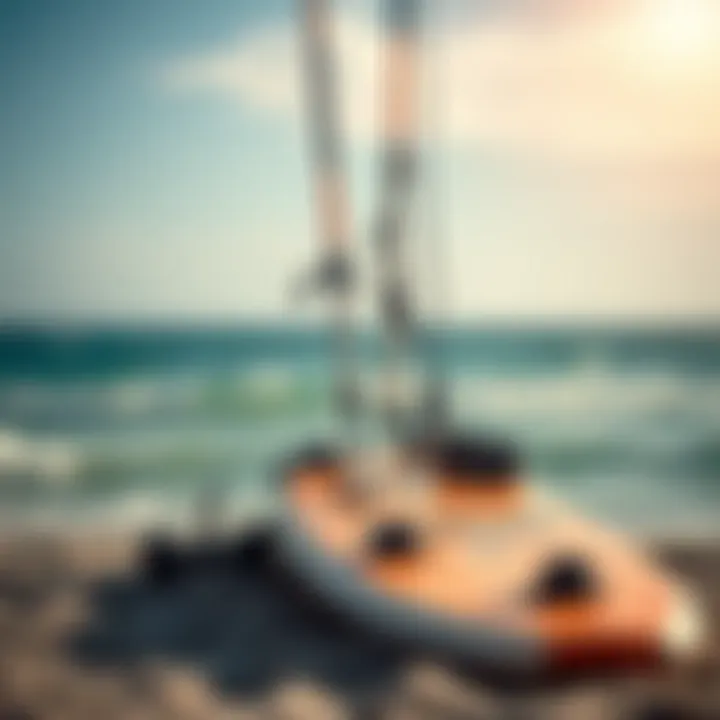
Travel Expenses for Kite Surfing
Travel costs play a significant role in determining the overall budget one will need for kite surfing. Unlike a fixed-location sport, kite surfing often requires traveling to various destinations characterized by suitable weather and ocean conditions. These expenses can quickly inflate your budget if not considered carefully. Thinking ahead can save you some significant coin while also ensuring you hit those prime spots ideal for the sport.
Choosing a Destination
The location you choose can greatly influence your travel expenses. Some places, like Hood River in Oregon or Tarifa in Spain, are serious meccas for kite surfers, attracting enthusiasts from across the globe. However, popular spots often come with a hefty price tag. Lodging, meals, and miscellaneous costs can pile up.
On the flip side, you may find hidden gems—less crowded beaches that could be a kite surfer's dream without the five-star hotel prices.
When picking a destination, consider:
- Accessibility: Is it easy to get to? Direct flights can save you both time and money.
- Local Conditions: Are the weather and winds predictable for kite surfing during your planned visit?
- Community and Support: Sometimes, a destination with a vibrant kite surfing community can lead to lower costs through shared gear rentals or group lessons.
Accommodations and Local Costs
Once your destination is chosen, the next step is finding a place to rest your head after an intense day on the water. Expect to weigh options between various accommodations:
- Hostels or Shared Housing: Economical but may lack privacy.
- Hotels: Can offer comfort but may also tip the budget.
- Airbnb or Vacation Rentals: Often come with kitchen facilities for cooking your meals, reducing the dining-out expenses.
Besides lodging, local costs also matter. Understandably, dining in tourist-heavy areas can be pricier. Consider venturing a little away from the major attractions for meals that are not only affordable but authentic.
Airfare and Transportation Logistics
Airfare is perhaps one of the biggest chunks of your travel expenses. A flight to a top kite surfing location can vary drastically in price depending on the time of year.
Here are a few pointers to keep costs manageable:
- Book in Advance: Flight prices tend to escalate as you approach your travel date.
- Use Fare Comparison Tools: Websites like Kayak or Skyscanner can help you find the best deals.
- Consider Connecting Flights: Sometimes opting for a longer route can shave off quite a bit from your total airfare.
Once you land, figuring out how to get around is another focus. If you plan on staying at a resort, expect transportation options to vary. Public transport, while often cheaper, may not align perfectly with your kite surfing schedule. Renting a car could give you the flexibility needed, but weigh that against rental and fuel costs.
Remember: Traveling is part of the kite surfing experience, so keeping an eye on expenses doesn’t mean skimping on good times. Finding a good balance will help preserve your financial health while still allowing you to enjoy the thrill of the sport.
Comparing Cost-Effective Strategies
When it comes to kite surfing, the thrill of riding the waves comes with varying costs that can stack up quickly. To pursue this exhilarating sport without breaking the bank, it helps to explore cost-effective strategies. By understanding how to manage and optimize your spending, you can indulge in this passion without feeling financially pinched. This section will delve into three primary strategies: buying used equipment, joining clubs or communities, and seizing off-season opportunities while maintaining the true essence of kite surfing.
Buying Used Equipment
Investing in kite surfing gear can feel like a hefty burden on one’s wallet. Thankfully, buying used equipment can alleviate some of that weight. The market for pre-owned gear is rich and often filled with fantastic finds from enthusiasts upgrading to the latest models. Here are a few things to keep in mind when looking for second-hand equipment:
- Inspecting Condition: It’s essential to examine used kites, boards, and other gear for wear and tear. Look for rips, faded patches, or worn fins. A meticulous inspection ensures you’re not purchasing something that’ll need costly repairs soon after.
- Source Reliable Vendors: Platforms like Facebook Marketplace or specialized sites like Kitefinder.com can be treasure troves of affordable gear. However, ensure the seller has a good reputation and check reviews if available.
- Consider Local Deals: Sometimes local shops have trade-in programs, where you can buy used equipment at a fraction of the new price. Don’t shy away from striking a deal as there’s often room for negotiation.
Buying used equipment not only saves money but is also an eco-friendly choice. It’s like giving second chances to beloved gear!
Joining Clubs or Communities
Community can play a pivotal role in kite surfing, as it provides a supportive environment for riders of all skill levels. Joining a kite surfing club or community can be a smart move financially:
- Collaborative Learning: Many clubs offer group lessons at reduced rates. This can save a pretty penny while allowing you to learn from experienced members who are passionate about sharing their knowledge.
- Access to Gear: Clubs often have a fleet of rental equipment available at lower prices compared to commercial rentals. This is especially useful if you’re still getting your feet wet and don’t want to commit to a full gear investment.
- Networking Opportunities: You can connect with other kite surfers, which might lead to shared trips or even gear swaps, thus cutting further costs.
In essence, being part of a kite surfing community not only enhances your skills but also opens doors to various financial benefits that can make a significant difference.
Off-Season Opportunities
Just as tides ebb and flow, so do prices in the kite surfing world. The off-season can be surprisingly advantageous when it comes to finding deals on gear and travel:
- Discounted Rates: During the low season, many rental shops and accommodations offer steep discounts, allowing you to enjoy kite surfing locations at a fraction of the cost.
- Fewer Crowds: Besides cost savings, off-season surfing often means less crowded beaches and better conditions. You can ride the waves with ample space, enhancing your overall experience.
- Plan Events: Some clubs hold off-season events or workshops at reduced rates. Participating in these can help you refine your skills while being mindful of your budget.
In summary, exploring the off-season allows not just for savings but also provides a unique experience this sport has to offer. Catching the best deals is like catching the perfect wave, both require timing and a bit of savvy.
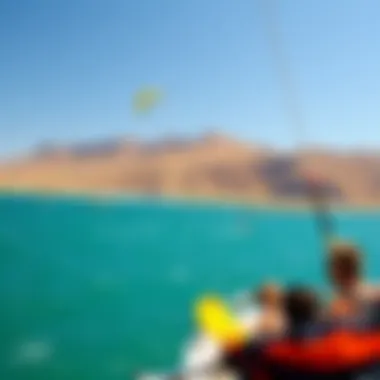
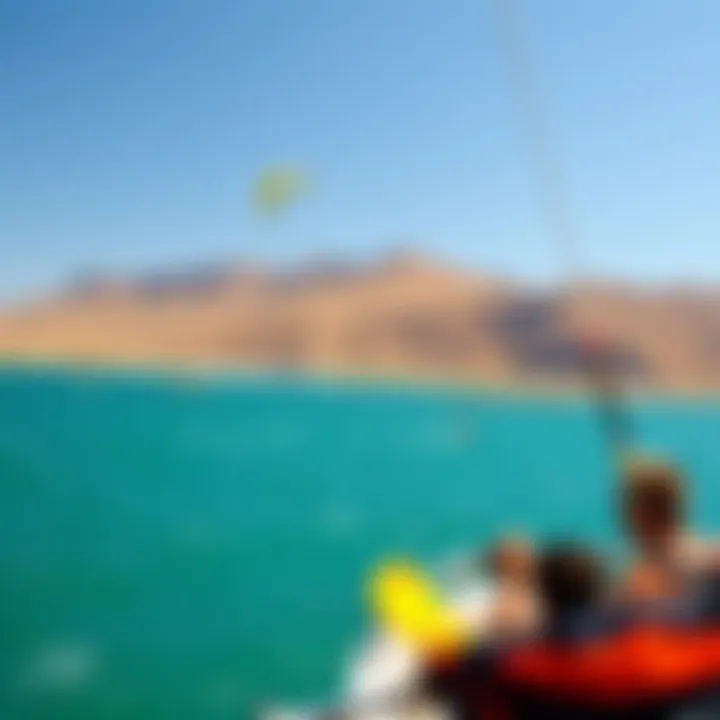
By taking the approach of purchasing used equipment, joining clubs, and capitalizing on off-season opportunities, kite surfing can transform from a pricey pastime into a sustainable passion that fits within your budget.
Insurance Considerations
When diving into the world of kite surfing, it's essential to think beyond just the gear and lessons. Insurance plays a pivotal role in protecting both your finances and your well-being as you ride the waves. Knowing the ins and outs of insurance can make a significant difference, especially when unexpected bumps or accidents come up. It’s not just about being fearless on the board; it’s about being smart off it too.
Liability Insurance Basics
Before you can feel the wind under your kite, you really should grasp liability insurance. This type of coverage is crucial for any kite surfer. Basically, it safeguards you against any legal claims that might arise if something goes wrong. Picture this: you’re out having the time of your life, and unfortunateley your kite unintentionally gets tangled with another surfer, causing them to get injured. If that goes to court, liability insurance can help cover the damages.
Some key points about liability insurance:
- Legal Protection: It helps you manage the financial fallout from accidents involving other people.
- Peace of Mind: Knowing you are covered allows you to focus on enjoying the sport fully. No one likes the burden of thinking about potential lawsuits while catching air.
- Breach of Rules: If you’re in a crowded area or a spot where kite surfing is restricted, a slip-up could bring hefty fines your way. Liability insurance can help cushion the blow.
Getting this type of coverage might feel like an extra burden, but it’s a wise safety net that can save you from significant financial strain.
Equipment Insurance Options
While understanding liability insurance is essential, don’t overlook the protection for your beloved gear – that's equally important. Equipment insurance covers the costs associated with repairs or replacements if your kite, board, or other gear gets damaged or stolen. Accidents happen, gear wears out, and sometimes the winds can be unforgiving.
Here’s what you should consider with equipment insurance:
- Covered Events: Look for policies that cover losses from theft, damage during transportation, or accidents while kiting. Of course, you don’t want to be caught off guard.
- Valuation: Make sure your gear's actual value is taken into account. If you just bought a brand-new kite, that’s what you want to insure, not some older model that doesn't ride as well anymore.
- Deductibles: Similar to car insurance, some policies include deductibles. Think about how much you’re willing to pay out-of-pocket before the insurance kicks in, as this can impact your monthly premiums.
- Specialized Policies: Some companies offer insurance specifically tailored for extreme sports enthusiasts, including kite surfing, which could provide broader coverage compared to standard insurance.
"In the world of kite surfing, preparing for the unpredictable is just as crucial as mastering the sport itself."
Whether you end up choosing comprehensive liability coverage, focused equipment insurance, or both, it’s important to weigh your options carefully. Investing wisely in insurance protects not only your experience but also your pocketbook, allowing you to focus on the thrill of kite surfing without the weight of uncertainty.
The Overall Value of Kite Surfing
When pondering the costs related to kite surfing, it's essential to consider the overall value and enjoyment the sport brings. This value intertwines financial investment with personal fulfillment, creating an experience that often extends beyond mere dollars and cents. As enthusiasts, we want to weigh the costs against our passions, understanding that those numbers are not just expenses but gateways to unforgettable memories and thrills on the water.
Weighing Costs Against Enjoyment
The initial investment may raise some eyebrows, especially for newcomers. The price tags attached to equipment, lessons, and travel can feel a bit overwhelming at first. However, it's crucial to shift perspective to consider the enjoyment derived from kite surfing.
- Adventure and Discovery: Each session becomes an adventure, allowing kite surfers to embrace nature while honing their skills. The exhilaration of a well-timed jump or the satisfaction of mastering a new trick can be rewarding in ways that monetary measures can't capture.
- Community Connection: Joining the kite surfing community can amplify the enjoyment factor. The friendships formed on beaches and through shared experiences turn the sport into a lifestyle. This social aspect should not be underestimated, often proving to be as valuable as the sport itself.
- Lifelong Skills: Think of kite surfing as an investment in personal development. The physical prowess gained, along with the confidence built from tackling challenges, can translate into various other disciplines in life. The joy of mastering a skill often outweighs the initial cost.
Ultimately, the question becomes, how much is the joy worth to you? The memories created and experiences gained often justify the initial expenditures, making it much more than just a pastime.
Physical and Mental Benefits
Engaging in kite surfing also yields significant physical and mental benefits. These elements form an intrinsic part of its appeal, beyond the financial investment.
- Physical Fitness: Kite surfing is a full-body workout. It engages core muscles while improving balance and strength. Regular sessions contribute to better overall fitness, fostering an active lifestyle that can be immensely rewarding.
- Mental Clarity: The zen-like focus required while riding can help clear the mind from daily stresses. The connection with the water and wind can serve as a form of moving meditation, allowing kite surfers to zone out from life's complexities.
- Emotional Well-being: The adrenaline rush and sheer joy of riding can boost happiness levels. Many practitioners find that kite surfing serves as an avenue for stress relief and emotional release, providing a healthy outlet for life's pressures.
- Connection with Nature: The experience of being immersed in nature while participating in kite surfing creates a deep appreciation for the environment. This connection often drives individuals to engage in environmental stewardship, fostering a sense of community around preserving beautiful ocean landscapes.
"Kite surfing is not just a sport; it's a lifestyle choice that shapes one's outlook on life, promoting health, happiness, and connection with nature."
In sum, the overall value of kite surfing transcends mere financial metrics. It incorporates adventure, community, fitness, mental health, and a broad range of emotional benefits. For many, this sport becomes an integral part of existence, making the costs seem trivial in contrast to the wealth of experiences it provides.
End
When embarking on the journey of kite surfing, understanding the financial commitment behind this thrilling sport is crucial. The costs can accumulate quickly, but being aware of them allows enthusiasts to budget appropriately and fully enjoy the experience without financial strain. In this article, we explored various components of kite surfing expenses, shedding light on everything from equipment to travel.
Summary of Key Points
- Equipment Costs: The initial investment in kites, boards, and harnesses can vary widely, ranging from a few hundred to several thousand dollars. Choosing the right gear is essential not just for performance, but also for safety.
- Lessons and Training: Proper training is key to mastering kite surfing. Depending on location and instructor qualifications, lesson prices can differ significantly. But investing in quality instruction pays dividends in skill and safety.
- Maintenance: Regular maintenance and occasional repairs are part of the long-term costs; knowing how to care for your equipment can save money in the long run.
- Travel Expenses: Kite surfing locations can dictate travel budgets. Planning ahead can lead to more affordable vacations, while being flexible with dates can open up cheaper options.
- Cost-Effective Strategies: From buying used equipment to joining local kiteboarding clubs, there are numerous ways to reduce costs without sacrificing the quality of experience.
Understanding these elements not only prepares future kite surfers for what to expect but also allows them to prioritize their financial planning around their passion for the sport.
Final Thoughts on Budgets and Adventures
As we finalize our discussion on kite surfing costs, it’s worth mentioning that diving into this exhilarating sport doesn't have to burn a hole in your pocket. Successful budgeting is about finding balance. It's about investing in quality gear while keeping an eye on potential cheaper alternatives.
Think of kite surfing as a journey rather than just an outdoor activity. Each wave you ride represents a moment of freedom that’s worth every penny spent. Engage with the community, research destinations, and plan ahead – these steps can help keep costs manageable. With this understanding, kite surfing can become a valued part of your lifestyle, allowing for adventures that entertain and inspire.
As you gear up and hit the water, remember: the key is not just to enjoy the thrill but to do so smartly, ensuring that every ride is a joyous memory rather than a financial regret.















